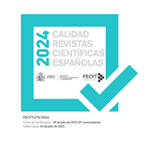The Mediatisation of the Chinese Dama in Chinese English-Language Media: A Cognitive Linguistic Approach
Resumen
The term ‘Chinese dama’ was originally coined by the Wall Street Journal in 2013 to refer to a group of middle-aged and elderly Chinese women who, somewhat frenetically, purchased gold or other items. This study employs a cognitive-linguistic approach to critical discourse analysis to examine how Chinese damas are linguistically mediatised in the Chinese English-language news media. A specialised corpus of 41 news articles with 26661 words, covering the years between 2013 and 2019, was built for this purpose. Informed by Maslow’s ‘hierarchy of needs’ theory, four most recurrent themes of Chinese dama news discourses were identified and coded. The analysis of these discourses suggests that whilst there is divergence in how newspapers construe Chinese damas’ participation in social activities when they are agentive, there is convergence in terms of schematising the conflicts between Chinese damas and the other parties. This seems to fit with the media’s ideological framework, steering ultimately towards the legitimisation of excluding Chinese female seniors from the public realm.
Descargas
Descarga artículo
Licencia
La revista Círculo de Lingüística Aplicada a la Comunicación, para fomentar el intercambio global del conocimiento, facilita el acceso sin restricciones a sus contenidos desde el momento de su publicación en la presente edición electrónica, y por eso es una revista de acceso abierto. Los originales publicados en esta revista son propiedad de la Universidad Complutense de Madrid y es obligatorio citar su procedencia en cualquier reproducción total o parcial. Todos los contenidos se distribuyen bajo una licencia de uso y distribución Creative Commons Reconocimiento 4.0 (CC BY 4.0). Esta circunstancia ha de hacerse constar expresamente de esta forma cuando sea necesario. Puede consultar la versión informativa y el texto legal de la licencia.











